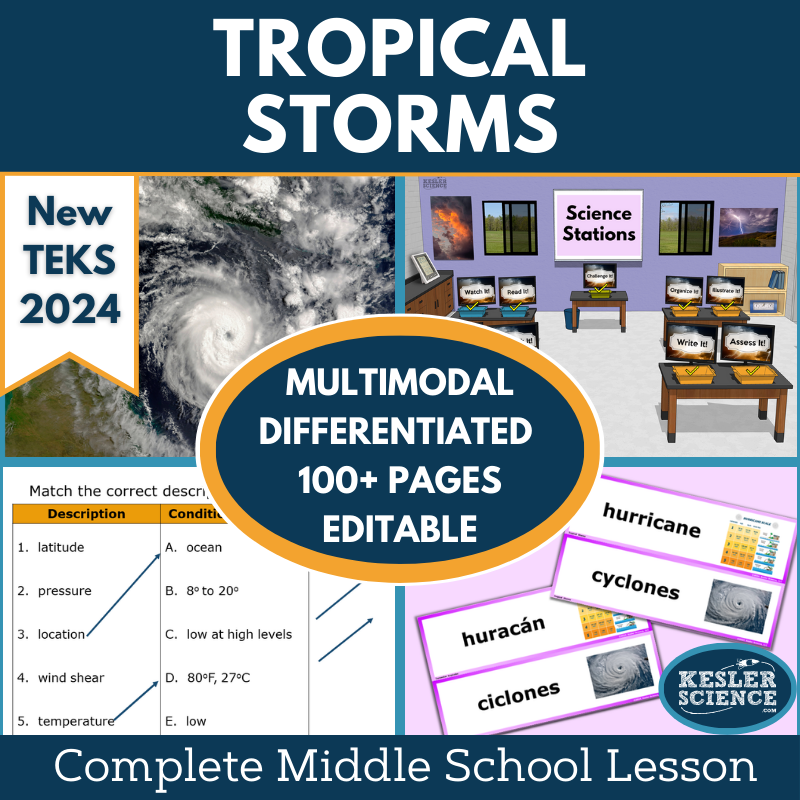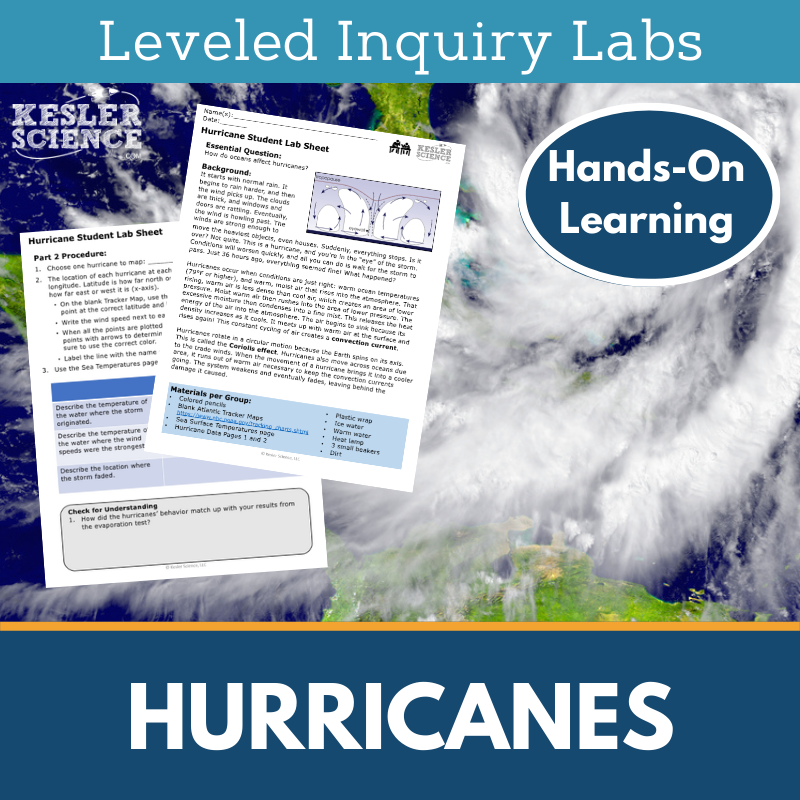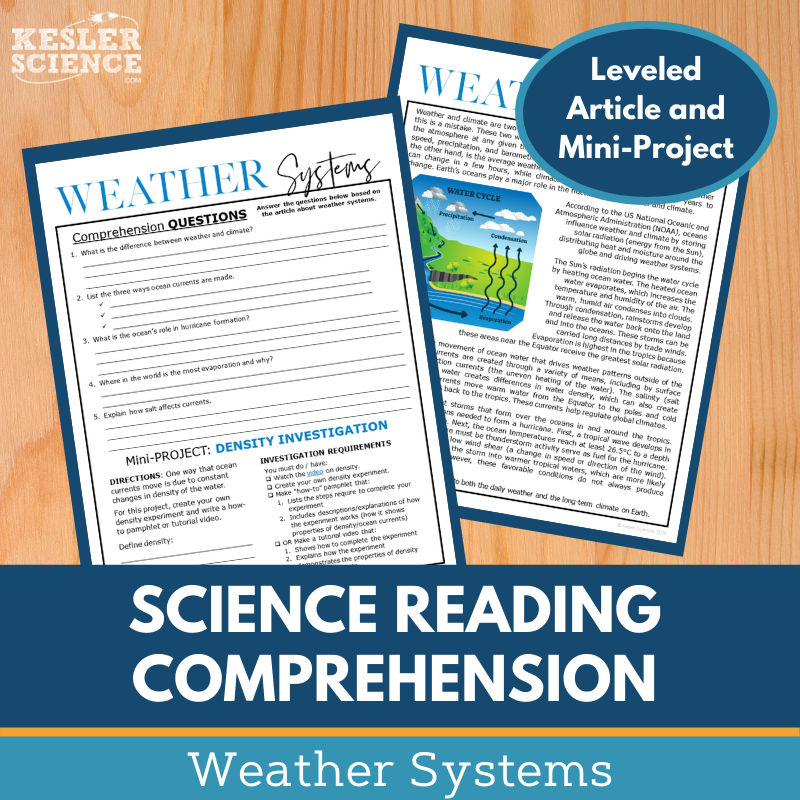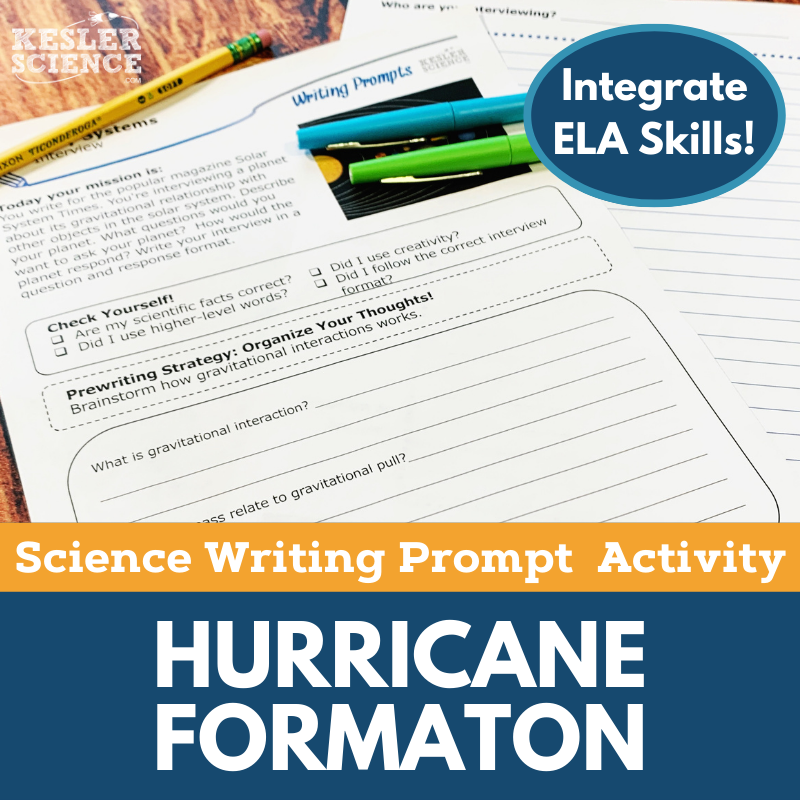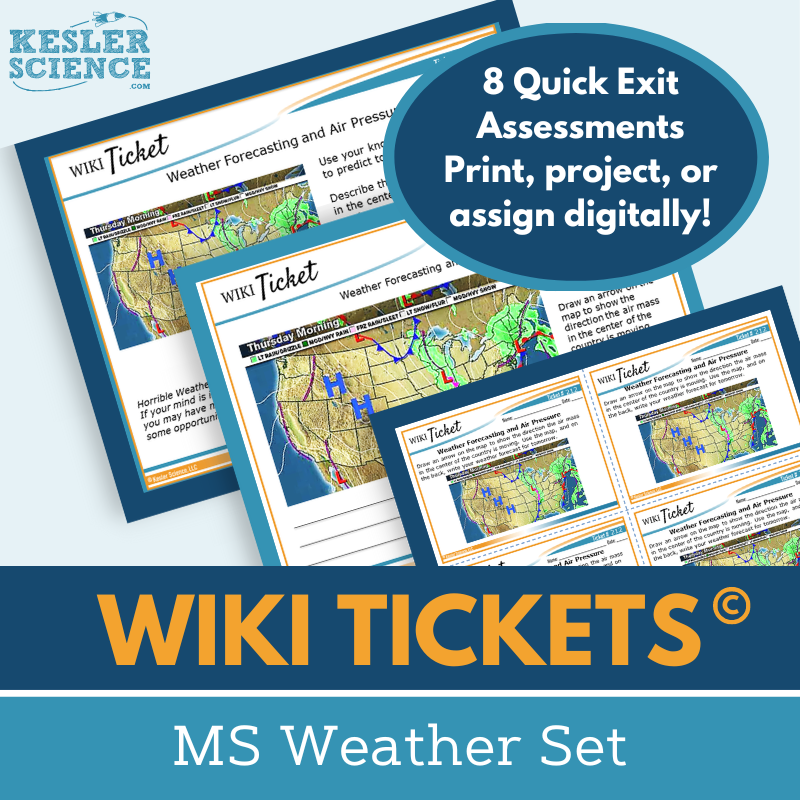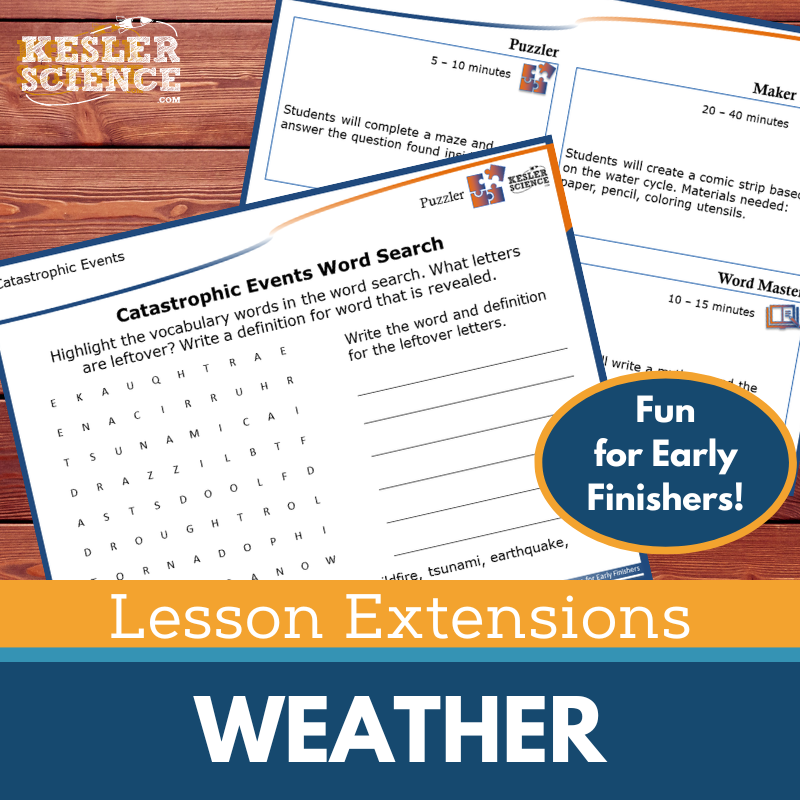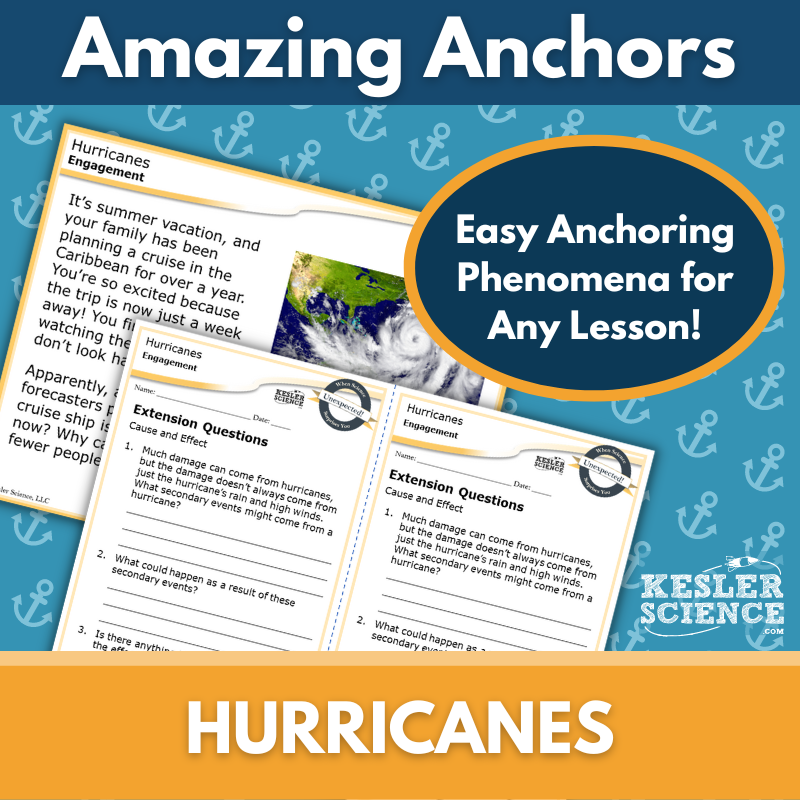Tropical Storms Activities for Middle School Science
Grasping the formation of tropical storms can be challenging for middle school students, but these engaging materials simplify the process! The resources below will give students a comprehensive understanding of tropical storms. All of the following materials are also included in the Kesler Science Membership.
The Kesler Science Tropical Storms Unit is an engaging middle school lesson on how ocean currents and air masses interact to form tropical storms, including hurricanes and typhoons. It includes editable PowerPoints, worksheets, assessments, and student-choice projects, all designed for differentiated, student-led learning with minimal prep.
Following the 5E Model, the unit provides engagement activities, a hands-on exploration station lab, editable PowerPoints, and interactive notebooks in English and Spanish. Students apply their learning through choice projects and STAAR 2.0-aligned assessments, with flexible digital and printable formats to fit any classroom. Multimodal learning strategies and Spanish translations support all learners.
Aligned with the 2021 TEKS 8.10C standard, this lesson is ideal for in-class or virtual learning. Bundle options offer savings on multiple topics or the complete curriculum, making it a comprehensive resource for teaching tropical storms and their impact in middle school science.
The Kesler Science Tropical Storms Unit is an engaging middle school lesson on how ocean currents and air masses interact to form tropical storms, including hurricanes and typhoons. It includes editable PowerPoints, worksheets, assessments, and student-choice projects, all designed for differentiated, student-led learning with minimal prep.
Following the 5E Model, the unit provides engagement activities, a hands-on exploration station lab, editable PowerPoints, and interactive notebooks in English and Spanish. Students apply their learning through choice projects and STAAR 2.0-aligned assessments, with flexible digital and printable formats to fit any classroom. Multimodal learning strategies and Spanish translations support all learners.
Aligned with the 2021 TEKS 8.10C standard, this lesson is ideal for in-class or virtual learning. Bundle options offer savings on multiple topics or the complete curriculum, making it a comprehensive resource for teaching tropical storms and their impact in middle school science.
Engage your middle school students with this student-led station lab aligned with the 2021 TEKS 8.10C standard. Designed for in-class or virtual learning, this lab helps students explore how ocean currents and air masses interact to create tropical cyclones, including hurricanes and typhoons, through nine interactive stations featuring videos, readings, research, and hands-on tasks.
Students showcase their understanding by organizing information, illustrating models, writing responses, and completing assessments. A bonus challenge station provides extension activities, and English and Spanish reading passages ensure differentiated learning.
This low-prep, high-engagement resource fosters active learning and critical thinking. Also included in the Weather Science Station Lab Bundle, which features seven Earth Science labs.
Engage your middle school students with this student-led station lab aligned with the 2021 TEKS 8.10C standard. Designed for in-class or virtual learning, this lab helps students explore how ocean currents and air masses interact to create tropical cyclones, including hurricanes and typhoons, through nine interactive stations featuring videos, readings, research, and hands-on tasks.
Students showcase their understanding by organizing information, illustrating models, writing responses, and completing assessments. A bonus challenge station provides extension activities, and English and Spanish reading passages ensure differentiated learning.
This low-prep, high-engagement resource fosters active learning and critical thinking. Also included in the Weather Science Station Lab Bundle, which features seven Earth Science labs.
The Tropical Storms Student Choice Projects align with the 2021 TEKS 8.10C standard, providing middle school students with multiple options to showcase their learning in a way that suits their strengths. A project page outlines six student-led options plus a “design your own” project, and an editable rubric supports teacher, peer, or self-assessment. This resource is also included in the Tropical Storms Complete Lesson for TEKS 8.10C.
These versatile, student-driven projects encourage creativity and engagement while allowing teachers to modify the rubric to fit grading needs. With multimodal choices, students can personalize their learning experience and demonstrate their understanding in meaningful ways.
Projects require common classroom materials like paper, markers, and scissors, with many activities available for digital completion. Also available in the Weather Bundle (five topics for grades 6-8) and the MEGA Student Choice Project Bundle (84 topics) for grades 6-8.
The Tropical Storms Student Choice Projects align with the 2021 TEKS 8.10C standard, providing middle school students with multiple options to showcase their learning in a way that suits their strengths. A project page outlines six student-led options plus a “design your own” project, and an editable rubric supports teacher, peer, or self-assessment. This resource is also included in the Tropical Storms Complete Lesson for TEKS 8.10C.
These versatile, student-driven projects encourage creativity and engagement while allowing teachers to modify the rubric to fit grading needs. With multimodal choices, students can personalize their learning experience and demonstrate their understanding in meaningful ways.
Projects require common classroom materials like paper, markers, and scissors, with many activities available for digital completion. Also available in the Weather Bundle (five topics for grades 6-8) and the MEGA Student Choice Project Bundle (84 topics) for grades 6-8.
Students will analyze the tracks of some of history’s most significant hurricanes, mapping their paths and identifying patterns in their formation and movement. By comparing hurricane data, students will explore how ocean temperatures and atmospheric conditions influence storm development and travel.
This resource includes three differentiated labs to support diverse learners. The Dependent Lab provides guided inquiry with structured support, the Modified Lab offers a more scaffolded approach with sentence stems and multiple-choice options, and the Independent Lab allows students to take full control of their investigation. Each lab comes with editable teacher resources, answer keys, and CER conclusion questions to reinforce key scientific concepts.
Students will need blank Atlantic tracker maps, hurricane data sheets, sea surface temperature charts, and hands-on materials like beakers, plastic wrap, ice water, warm water, dirt, and a heat lamp. The lesson aligns with TEKS 8.10C, emphasizing the role of oceans in the formation of hurricanes.
Save time and bundle! This lab is also available in the Complete Inquiry Labs Bundle, making hands-on weather investigations even easier for the classroom.
Students will analyze the tracks of some of history’s most significant hurricanes, mapping their paths and identifying patterns in their formation and movement. By comparing hurricane data, students will explore how ocean temperatures and atmospheric conditions influence storm development and travel.
This resource includes three differentiated labs to support diverse learners. The Dependent Lab provides guided inquiry with structured support, the Modified Lab offers a more scaffolded approach with sentence stems and multiple-choice options, and the Independent Lab allows students to take full control of their investigation. Each lab comes with editable teacher resources, answer keys, and CER conclusion questions to reinforce key scientific concepts.
Students will need blank Atlantic tracker maps, hurricane data sheets, sea surface temperature charts, and hands-on materials like beakers, plastic wrap, ice water, warm water, dirt, and a heat lamp. The lesson aligns with TEKS 8.10C, emphasizing the role of oceans in the formation of hurricanes.
Save time and bundle! This lab is also available in the Complete Inquiry Labs Bundle, making hands-on weather investigations even easier for the classroom.
In this engaging lesson, students explore the role of oceans in weather systems by reading a nonfiction article on how hurricanes and other weather patterns form. They answer comprehension questions and conduct a hands-on density experiment. Designed for grades 6-8 (and advanced 5th graders), the resource includes two Lexile-leveled passages (1100-1300) to support science literacy and differentiation.
The lesson features 5-7 comprehension questions, a mini-experiment, and a Cornell notes template. Colorful, printable graphics enhance engagement, and the resource is compatible with Google Classroom, MS Teams, Schoology, and Canvas, making it ideal for in-class or virtual learning. Students can annotate and respond directly within the digital document for seamless integration.
Perfect for absent students, sub plans, extra credit, or whole-class instruction, this versatile resource reinforces science literacy, discussion, and critical thinking. The Science Reading Comprehension Passages Vol. 1 bundle offers 40 additional passages, expanding opportunities for textual analysis and comprehension practice.
In this engaging lesson, students explore the role of oceans in weather systems by reading a nonfiction article on how hurricanes and other weather patterns form. They answer comprehension questions and conduct a hands-on density experiment. Designed for grades 6-8 (and advanced 5th graders), the resource includes two Lexile-leveled passages (1100-1300) to support science literacy and differentiation.
The lesson features 5-7 comprehension questions, a mini-experiment, and a Cornell notes template. Colorful, printable graphics enhance engagement, and the resource is compatible with Google Classroom, MS Teams, Schoology, and Canvas, making it ideal for in-class or virtual learning. Students can annotate and respond directly within the digital document for seamless integration.
Perfect for absent students, sub plans, extra credit, or whole-class instruction, this versatile resource reinforces science literacy, discussion, and critical thinking. The Science Reading Comprehension Passages Vol. 1 bundle offers 40 additional passages, expanding opportunities for textual analysis and comprehension practice.
The Hurricane Formation Science Writing Prompt Activity engages middle school students in Earth science concepts through a news event reporting exercise. This activity enhances scientific reasoning and writing skills while exploring how ocean interactions contribute to hurricane development.
Aligned with TEKS and NGSS, this low-prep resource includes teacher directions, project ideas, rubrics, projection-ready prompts, full-sized handouts, and a digital version for Google Slides or PowerPoint.
Ideal for cross-curricular learning, formative assessments, student choice projects, early finishers, extra credit, and differentiation, this activity reinforces science literacy and critical thinking. With 145 topics available, students can showcase their work or compile them into an interactive science writing collection.
The Hurricane Formation Science Writing Prompt Activity engages middle school students in Earth science concepts through a news event reporting exercise. This activity enhances scientific reasoning and writing skills while exploring how ocean interactions contribute to hurricane development.
Aligned with TEKS and NGSS, this low-prep resource includes teacher directions, project ideas, rubrics, projection-ready prompts, full-sized handouts, and a digital version for Google Slides or PowerPoint.
Ideal for cross-curricular learning, formative assessments, student choice projects, early finishers, extra credit, and differentiation, this activity reinforces science literacy and critical thinking. With 145 topics available, students can showcase their work or compile them into an interactive science writing collection.
These 6th-8th grade science formative assessments offer fun and flexible ways to check student understanding. The Weather Set includes eight WIKI Tickets© assessments in five formats: projection, three printable handouts, and a digital version for Google Slides or PowerPoint. These interactive and adaptable assessments fit any classroom setup.
Aligned with NGSS and TEKS standards, WIKI Tickets© cover topics such as the greenhouse effect, ocean currents, weather maps, and natural hazards. A table of contents ensures easy standard alignment and full coverage of key weather concepts.
WIKI Tickets© (“What I Know Is”) can be used as exit tickets, bellringers, or quick progress checks. Teachers can project, print, or assign digitally for in-person or virtual learning. These ready-to-use assessments make monitoring student progress simple and effective.
These 6th-8th grade science formative assessments offer fun and flexible ways to check student understanding. The Weather Set includes eight WIKI Tickets© assessments in five formats: projection, three printable handouts, and a digital version for Google Slides or PowerPoint. These interactive and adaptable assessments fit any classroom setup.
Aligned with NGSS and TEKS standards, WIKI Tickets© cover topics such as the greenhouse effect, ocean currents, weather maps, and natural hazards. A table of contents ensures easy standard alignment and full coverage of key weather concepts.
WIKI Tickets© (“What I Know Is”) can be used as exit tickets, bellringers, or quick progress checks. Teachers can project, print, or assign digitally for in-person or virtual learning. These ready-to-use assessments make monitoring student progress simple and effective.
Lesson Extensions provide engaging, student-driven activities that challenge fast finishers with critical thinking and creativity. Designed to reinforce learning while preventing distractions, these activities are ideal for wrapping up lessons, filling downtime during testing, or enriching curious minds. Aligned with NGSS and TEKS weather standards, they offer rigorous yet fun opportunities for deeper exploration.
Each extension includes four activities: Puzzler enhances problem-solving skills with interactive challenges, Maker Space promotes STEAM connections through hands-on projects, Tech Connection allows students to showcase learning through digital media, and Word Master integrates creative writing into science. These flexible formats enable students to engage with key concepts in ways that best suit their learning style.
This resource includes teacher directions, answer keys, projection slides for digital classrooms, and full- and half-sheet printable versions for various classroom setups. Covering topics like catastrophic events, hurricane formation, and the water cycle, these high-level lesson extensions provide meaningful enrichment while reinforcing science literacy and exploration.
Lesson Extensions provide engaging, student-driven activities that challenge fast finishers with critical thinking and creativity. Designed to reinforce learning while preventing distractions, these activities are ideal for wrapping up lessons, filling downtime during testing, or enriching curious minds. Aligned with NGSS and TEKS weather standards, they offer rigorous yet fun opportunities for deeper exploration.
Each extension includes four activities: Puzzler enhances problem-solving skills with interactive challenges, Maker Space promotes STEAM connections through hands-on projects, Tech Connection allows students to showcase learning through digital media, and Word Master integrates creative writing into science. These flexible formats enable students to engage with key concepts in ways that best suit their learning style.
This resource includes teacher directions, answer keys, projection slides for digital classrooms, and full- and half-sheet printable versions for various classroom setups. Covering topics like catastrophic events, hurricane formation, and the water cycle, these high-level lesson extensions provide meaningful enrichment while reinforcing science literacy and exploration.
This Amazing Anchors lesson provides a no-prep, real-world approach to understanding hurricanes and their impact on landscapes. The two-part resource begins with an engaging reading on a major 2017 hurricane, followed by comprehension and extension questions that guide students through key concepts. The second reading breaks down the science behind how hurricanes alter the environment, reinforcing learning with follow-up questions.
This lesson includes teacher directions, answer keys, projection slides, a digital version for LMS platforms, and printable handouts. Aligned with TEKS, it helps students connect scientific principles to real-world natural disasters, making earth science more meaningful and engaging.
Designed for both in-person and virtual learning, this resource is print- and digital-friendly. A modified version with sentence starters and simplified language supports differentiation, making it accessible for all learners. Whether used to introduce or review key ideas, this interactive, standards-aligned lesson fosters science literacy and critical thinking.
This Amazing Anchors lesson provides a no-prep, real-world approach to understanding hurricanes and their impact on landscapes. The two-part resource begins with an engaging reading on a major 2017 hurricane, followed by comprehension and extension questions that guide students through key concepts. The second reading breaks down the science behind how hurricanes alter the environment, reinforcing learning with follow-up questions.
This lesson includes teacher directions, answer keys, projection slides, a digital version for LMS platforms, and printable handouts. Aligned with TEKS, it helps students connect scientific principles to real-world natural disasters, making earth science more meaningful and engaging.
Designed for both in-person and virtual learning, this resource is print- and digital-friendly. A modified version with sentence starters and simplified language supports differentiation, making it accessible for all learners. Whether used to introduce or review key ideas, this interactive, standards-aligned lesson fosters science literacy and critical thinking.
Year-Round Resources
These year-round activities will increase your students' understanding of many middle school science topics. All of these activities are also included in the Kesler Science Membership.
Visual Data & Graphing
You're not alone if your students struggle with understanding graphs, charts, and tables. It's a skill that takes an enormous amount of practice. This resource will help students build a strong foundation in analyzing data and creating their own data visualizations.
Bell Ringers and Warm-Ups
These middle school science bell ringers are an excellent way to engage your students as soon as they walk into your classroom. This comprehensive FULL YEAR resource includes everything you need to start off each science class with an interesting warm-up activity.
Review Board Games
Each game board has been carefully designed to keep students engaged. There are 10 different action spaces on each board and dozens of question cards. All of the actions are related to science concepts and keep the students motivated throughout the game.
Each game is ready to play. Simply print out the board and the cards and let the students enjoy reviewing nine different units.
Essential Questions and Standards
Below are the essential questions and standards associated with the lessons and activities included in the atoms unit. This topic is only one of more than 100 middle school science topics included in the Kesler Science Membership.
-
What role do ocean currents and air masses play in the formation of tropical storms?
-
How are tropical storms formed, measured, and tracked?
-
TEKS Science - 8.10C Tropical Storms
Kesler Science Membership
Imagine never having to search for another middle school science lesson again. The membership gives you access to ALL of the Kesler Science products in one place (Yes, including everything above).
Say goodbye to long hours of lesson prep.

